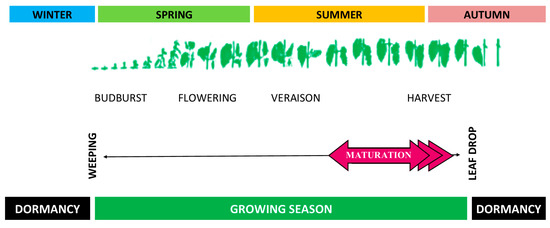Among all atmospheric elements, air temperature is considered the most important in driving the growth and development of grapevines [
19], in cases where water, radiation, and nutrient requirements of the plant are fulfilled [
20,
21]. From the climatological viewpoint, the distribution of traditional viticultural regions worldwide is mainly confined within a belt defined by the isotherms of average growing season temperatures (April–October, NH; October–April, SH) of 12–13 °C and 22–24 °C [
12], underlining the key role played by temperature on viticultural suitability. Growing season temperatures below 12–13 °C commonly occur in regions with growing seasons too short for proper vine development, with typically low solar radiation levels and insufficient heat accumulation. On the other hand, growing season temperatures above 22–24 °C often lead to excessive heat stress on vines, which is also frequently associated with either severe water stress, in dry climates, or strong pest and disease pressures, in humid climates. These areas may also have difficulty in meeting the chilling requirements for the dormancy period, with resulting erratic bud break [
12].
For the meteorological timescales, temperature conditions strongly control both grapevine physiology and berry composition during the preceding and the current growing season [
22,
23]. The inflorescence primordia differentiation starts around the bloom stage of the preceding year [
24,
25]. Warm and sunny conditions during this period promote the formation of inflorescence primordia, whereas cool and cloudy weather promotes the formation of tendrils [
26,
27]. Hence, the environmental conditions in the preceding year have a direct influence on the yield of the following season [
28].
From leaf fall to the beginning of spring, grapevines are dormant and consist entirely of woody tissue, with little physiological activity [
3]. This period encompasses two sub-periods that are controlled by endogenous and exogenous thermal factors needed for dormancy release. The first sub-period (endo-dormancy) is triggered by chilling accumulation (chill units) during autumn/winter, whereas the second sub-period (eco-dormancy) is driven by heat accumulation until bud break. Therefore, the winter chill is an important condition for grapevine growth development, as cold promotes bud dormancy [
29,
30], besides other processes such as day length shortening and ageing of the photosynthetic active parts of the plants. From late winter to early spring, the accumulation of daily mean temperatures above 7 to 10 °C generally promote dormancy break and the onset of the grapevine growing cycle [
31].
During the growing season, grapevines undergo constant changes in terms of morphology and physiology. The length of the growing season for each variety is directly related to the growing season mean air temperature [
32], though it may be additionally linked to soil moisture and crop management practices [
33]. The length of the different phenological stages significantly differs not only according to each variety, but also to the thermal conditions in a given region for each specific year [
34,
35]. Despite relatively high resilience to abiotic stresses, extremely low temperatures during winter [
36], negative temperatures (Celsius scale) around/after budburst [
37,
38,
39,
40], and hail events may severely damage the developing buds, leaves, and inflorescences [
41,
42]. Cool conditions [
38] or extreme heat [
28,
43,
44] may also affect vine physiology and yield, though some grapevine varieties are more tolerant to extreme temperatures than others. Grapevines under severe heat stress may undergo a significant decrease in photosynthetic productivity, as well as suffer injures in other biochemical processes [
45]. Extreme events during the veraison–maturity period, such as heatwaves, can significantly influence sugar accumulation [
46] and may lead to a decrease in anthocyanin biosynthesis and content [
47]. Secondary metabolites, more specifically phenolics, due to their contribution to colour, flavour, aroma, texture, astringency, and stabilization of wine, as well as antioxidant properties [
48], are extremely important for fruit quality and wine production [
49]. High temperatures may also lead to important losses, as they also influence the synthesis of volatile compounds, which strongly contribute to the sensory character of wines [
50]. In autumn, the gradual shortening of the day length and decreasing of temperatures promote acclimation to freezing temperatures in winter. During this phase, the translocation of carbohydrates, amino acids, organic acids, and some minerals from leaves to perennial organs (trunk and roots) reaches its maximum [
51]. This period, considered as a survival strategy, ordinarily coincides with the generalized leaf senescence, followed by leaf fall and the subsequent dormancy period.

